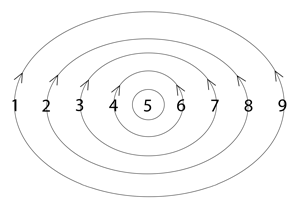reflection
7-1-8
Conventional Understanding
We typically define reflection as the throwing back of light or sound by a surface, or as careful thought about something. When we “reflect,” we either physically bounce back waves or mentally contemplate past experiences. This limited understanding creates an artificial separation between the process of reflection and what it reveals, teaching us to view reflection as either a mechanical occurrence or a technique we employ rather than recognizing it as the fundamental mirror through which reality recognizes itself.
Resonant Understanding
Word Cosmology reveals “reflection” carrying a 7-1-8 resonance pattern, sharing this numeric signature with “quantum” and “individuate an idea,” illuminating reflection not as a technique but as the fundamental process through which reality recognizes its patterns. Like a river flowing over stones that simultaneously shapes and is shaped by what it encounters, reflection manifests as the living interchange where potential becomes distinct expression. This connection to “quantum” suggests that the mysterious “observer effect” in physics might simply be patterns individuating themselves through reflection.
Expressions Spectrum Analysis
In balanced expression, this resonance pattern appears as “alignment with desire,” “being the mirror,” and “effortless,” revealing how reflection naturally corresponds with clear recognition without struggle. “I am experiencing” demonstrates direct participation rather than analytical distance, while “individuate an idea” shows how reflection naturally brings distinct patterns into expression.
When over-modulated, expressions include “anticipate,” “my power is important,” and “projected thinking,” revealing how reflection becomes distorted through attempts to control what it reveals. “Goal” and “monetize” show the tendency to use reflection for predetermined outcomes rather than allowing natural recognition.
Under-modulated expressions such as “cloudy,” “disappear,” and “amnesia” demonstrate what happens when the reflecting surface lacks sufficient clarity. “I can’t share” reveals the disconnection that characterizes insufficient reflection.
Russell’s Cosmogony Connection
Walter Russell understood reality as a mirror process:
“The fulcrum of the universe from which actions and reactions extend and return might be likened unto a mirror.”
This corresponds with how reflection functions at the quantum level, where observation and manifestation arise together. Consider how a lake reflects the sky—the reflected image isn’t the sky itself, nor separate from it, but the point where the sky becomes visible to itself. Similarly, reflection serves as the mirror where reality recognizes its own patterns.
Practical Implications
This understanding transforms reflection from a technique we employ to a capacity we naturally embody. Rather than analytical exercises on past events, we might recognize reflection as the continuous mirror already functioning through us. The balanced expressions suggest allowing natural interest to direct attention rather than forcing interpretation, maintaining steady presence, and trusting that clear reflection happens naturally when we don’t interfere.
By recognizing reflection as the natural process where reality recognizes itself through us, we participate more consciously in the creative unfolding rather than seeing ourselves as separate observers trying to understand an external world.
Walter Russell’s quotes are from his book, “A New Concept of the Universe”.
Related Words:
No results found.


